#hemiphractidae
Text
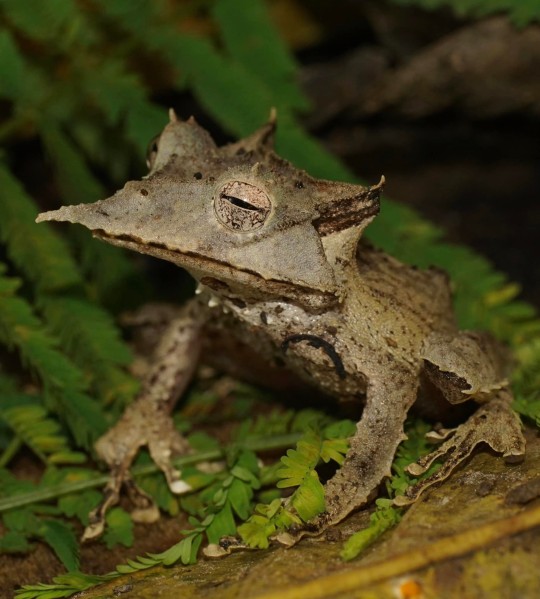

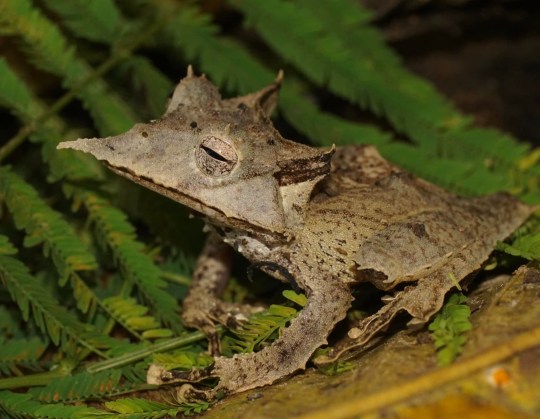
Sumaco Horned Treefrog (Hemiphractus proboscideus), family Hemiphractidae, Loreto, Peru
photographs by Matt Jeppson
15K notes
·
View notes
Note
Found your account from one of my mutuals reblogging that one mini frog post, could I learn about some fucked up frogs :D
Everybody is always banging on about Pipa pipa. Nobody is ever talking about how fucked up Hemiphractidae reproduction is
Like, they range from concealed carry, like this Gastrotheca orophylax

[src]
which they achieve with a pouch that has a weird ass opening (lack of hyphenation intentional) (not actually anywhere near the cloaca of the frog) (this has earned them the common name 'marsupial frogs' for a very obvious reason)
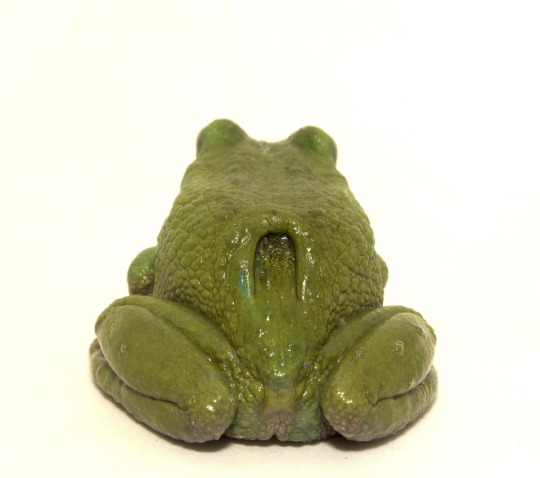
[src]
…to open carry, like this Fritziana goeldii
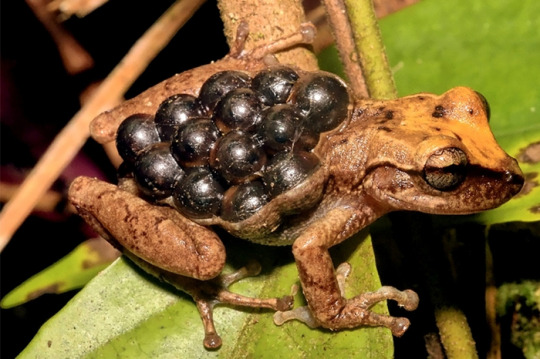
[src]
which hatch out but remain glued on until developing sufficiently, like this Cryptobatrachus boulengeri

[src]
Pretty fucked up, if you ask me.
#frogs#fucked up#nature#wild#animals#herpetology#zoology#biology#what the fuck is up with that#I feel like I should tw a phobia#but like#what phobia even is this#it's not really trypophobia#who had 'a cornucopia of froglets' on their bingo card?#anyway Hemiphractidae are amazing#excellent frogs#weird though#it is Wednesday my dudes#sweethibiscustea82#answers by mark#cw trypophobia#cw body horror
2K notes
·
View notes
Text

Sumaco Horned Treefrog (Hemiphractus proboscideus), family Hemiphractidae, Loreto, Peru. photographs by Matt Jeppson
2 notes
·
View notes
Text

Sumaco Horned Treefrog (Hemiphractus proboscideus), family Hemiphractidae, Loreto, Peru
photographs by Matt Jeppson
0 notes
Photo

Gastrotheca argenteovirens by Andrés Mauricio Forero Cano
#Anura#Hemiphractidae#Gastrotheca#Gastrotheca argenteovirens#frog#frogs#animal#animals#biology#nature#wildlife#amphibian#amphibians#zoology#herpetology#herps#fauna#critter#critters
126 notes
·
View notes
Photo

#Gastrotheca cornuta — The Eyelash Marsupial Frog is named for the pouch on the females back to carry her offspring through direct development. This species skips the free-swimming larval stage and tiny frogs emerge from her pouch once development is complete. This species belongs to the family #Hemiphractidae and many species in this family do wacky things with their developing offspring, such as carry them around in a pouch or just stick them to their back, as is the case with the Hemiphractid #BackpackFrogs (at The Amphibian Foundation) https://www.instagram.com/p/BrvIv7zg9Lt/?utm_source=ig_tumblr_share&igshid=1diwebfb6163m
132 notes
·
View notes
Photo

A Spix’s horned toad carries eggs on its back. This photograph was taken by Jasmine Vink, the winner of the wildlife and animal category and overall winner in the Australian Photography’s 2018 Photographer of the Year competition
Photograph: Jasmine Vink/Australian Photography Magazine
(via The week in wildlife – in pictures | Environment | The Guardian)
#Spix's Horned Treefrog#Hemiphractus scutatus#Hemiphractus#Hemiphractinae#Hemiphractidae#Neobatrachia#Anura#Lissamphibia#Amphibia#amphibian#treefrog#frog#eggs#forest#Ecuador
45 notes
·
View notes
Video
San Lucas Marsupial Frog, Gastrotheca pseustes by Andreas Kay
Via Flickr:
from Ecuador: www.flickr.com/andreaskay/albums
#amphibian#Andreas Kay#Anura#Ecuador#focus stack#frog#Gastrotheca pseustes#Hemiphractidae#San Lucas Marsupial Frog#Triunfo
316 notes
·
View notes
Photo

Two new species of marsupial frogs (Anura: Hemiphractidae) from the Central Andes of northern Peru.
Echevarría, L. Y., D. J. Paluh, L. A. García-Ayachi, P. J. Venegas, A. Catenazzi, R. Pradel & S. Castroviejo-Fisher
Abstract.
We describe two new species of Gastrotheca from the humid montane forests and grasslands of La Libertad and Amazonas departments, respectively, in the northern portion of the central Peruvian Andes.
Our phylogenetic analysis recovered the new species as part of the Gastrotheca marsupiata species group and closely related to G. gemma, G. oresbios, G. psychrophila, G. spectabilis, G. stictopleura, and one undescribed species.
The new species from La Libertad department can be differentiated from the aforementioned congeners by being of moderately small size (SVL = 33.3–41.9 mm, N = 3), having an acutely rounded snout in dorsal view, a rounded snout in lateral view, smooth skin on the dorsum with low granules, and smooth tympanic annulus and supratympanic fold.
The new species from Amazonas department (SVL = 33.5–43.9 mm, N = 2) differs from other Gastrotheca species by having the dorsum covered with large and closely packed rounded pustules, two prominent paravertebral longitudinal pustular ridges, and a distinctly thick and elevated supratympanic fold extending from the top edge of the tympanum to the flank and being continuous or fused with the dorsolateral row of elongated pustules.
In addition to external morphological characters, we include detailed descriptions and illustrations of the skeleton of the holotypes based on 3D models obtained from CT-scans.
Read the paper here:
https://salamandra-journal.com/index.php/home/contents/2022-vol-58/2067-echevarria-l-y-d-j-paluh-l-a-garcia-ayachi-p-j-venegas-a-catenazzi-r-pradel-s-castroviejo-fisher
181 notes
·
View notes
Text
Megapixels: Mini frog, two frog, pumpkin frog, new frog
New Post has been published on https://nexcraft.co/megapixels-mini-frog-two-frog-pumpkin-frog-new-frog/
Megapixels: Mini frog, two frog, pumpkin frog, new frog
Last week was chock-full of frog news, both heart-warming and heart-breaking. Here are the top four photo-worthy events:
See Sehuencas water frogs in love
Romeo (pictured above in all his orange tummy glory), was thought to be the last Sehuencas water frog in existence. Ever since biologists scooped him out of the wilds of Bolivia, he’s been the most eligible frog bachelor in the world. Most recently, the Global Wildlife Conservation group created a Match dot com dating profile in order to find Romeo his better half—by sending an expedition to South America. The search worked: biologists identified two males and three females of the same species in Bolivian cloud forests, densely-wooded regions perpetually enshrouded in canopy-level silvagenitus clouds. On Monday, the conservation group announced that Romeo had successfully bonded with a mate, aptly named Juliet. The two lovers can be seen below.
Lonely Romeo had stopped making mating calls altogether in 2017. But according to a press release, he began ribbeting again in March, after Juliet moved into his aquarium. The duo have so far struggled with mating, however. Romeo hasn’t assumed the right position for amplexus—the frog mating ritual where females lay eggs as the males fertilize them from behind—often enough or long enough (some male frogs can keep the shape for “week or even months,” according to a press release). But his caretakers remain hopeful.
Meet the new genus, Mini
Herpetologist Mark Scherz and his colleagues recently published a study in PLOS ONE announcing they’d identified five new miniature frog species in Madagascar. Three are named “Mini mum, Mini scule, and Mini ature, because I am HILARIOUS,” Scherz tweeted. He’s serious: the frog seen above, perched on a fingernail, is a real, live Mini mum. The new species have been described as “staple-sized” and “astronomically-small”. Going forward, the researchers hope to better understand how the frogs, which span three genera, evolved to be so teeny.
… And an invasive frog-killing fungus
The Helena’s marsupial frog, seen above, is a member of the Hemiphractidae family, which live in Central and South America. These photogenic amphibians are threatened by a deadly fungus, chytridiomycosis, or simply chytrid. The fungus is the most invasive species in the world, according to a new report in the journal Science. It has negatively affected a whopping 501 amphibious species. When chytrid creeps across the porous skin of a frog, toad, or salamander, it impedes electrolyte transport, and ultimately triggers a fatal heart attack.
Watch pumpkin toads fluoresce
Despite its cute common name, the pumpkin toadlet is actually a very poisonous frog. Its bright colors are a warning sign—a biological phenomenon called aposematism. But it turns out the frogs, native to the Atlantic forest along the coast of Brazil, have been keeping their niftiest feature to themselves. When Sandra Goutte, a postdoctoral associate at NYU Abu Dhabi, and her colleagues “discovered that Brachycephalus ephippium could not hear its own mating calls, they searched for alternative visual signals the frogs could use to communicate instead,” according to a press release. They shined a UV light on the hoppers, and were surprised to find their backs glowed. Turns out, the pumpkin toadlet’s skeleton is unusually fluorescent, according to the new research published Friday in the journal Scientific Reports. Because their skin is so thin, the UV lamp actually hit the bones of the two specimens under analysis, triggering that eerie gleam.
Written By Eleanor Cummins
0 notes
Text
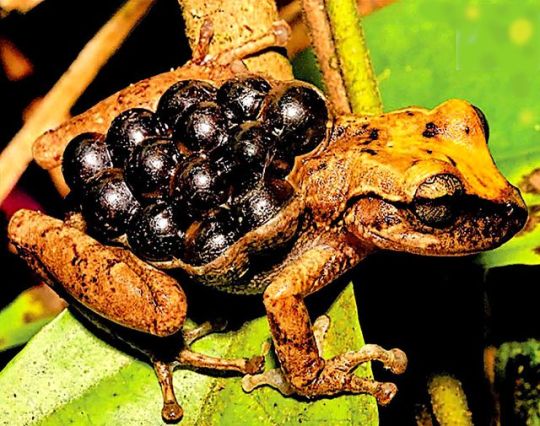
Goeldi's Frog (Fritziana goeldii), adult with eggs, family Hemiphractidae, endemic to SE Brazil
The female glues her eggs onto a sticky pad on her back and carries them until the are near hatching. After about 19 days, she places them into water in a bromeliad, and the tadpole hatch soon thereafter.
photograph via: Nunes-de-Almeida et al.
426 notes
·
View notes
Photo

regram @mustafagultekinavsar #FrogsOfinstagram #FrogsLifeSeria #MarsupialFrogsSeria #Frog #FrogsSeria #KurbagalarSeria #SilverMarsupialFrogsSeria Kingdom: #AnimaliaSeria Phylum: #ChordataSeria Class: #AmphibiaSeria Order: #AnuraSeria Family: #HemiphractidaeSeria Genus: #GastrothecaSeria Species: #GastrothecaPlumbeaSeria Binomial name #GastrothecaPlumbea (Boulenger, 1882) The #SilverMarsupialFrog (Gastrotheca plumbea; in Spanish: rana marsupial bromelícola) is a species of frog in the Hemiphractidae family. It is endemic to the Pacific slopes of Andes in northern and central Ecuador. It is a nocturnal, arboreal inhabitant of cloud forests that can also be found in forest edge and secondary, degraded habitats. It is closely associated with arboreal bromeliads. It is threatened by habitat loss. regram @ natgeo photo by @joelsartore | An #EndangeredSeria #MarsupialFrog at Pontificia Universidad Católica in Quito, #EcuadorAnimalsSeria #SouthAmericaAnimalsSeria #EcuadorFrogsSeria #SouthAmericaFrogsSeria #AndesAnimalsSeria Follow me to see more members of the #february03subat2016 #subat03seria #subat2016seria #çarşambaseria #carsambasubatseria #carsamba2016seria
#marsupialfrogsseria#hemiphractidaeseria#animaliaseria#southamericaanimalsseria#amphibiaseria#february03subat2016#frog#frogsseria#gastrothecaplumbeaseria#andesanimalsseria#anuraseria#gastrothecaseria#silvermarsupialfrog#frogslifeseria#ecuadoranimalsseria#endangeredseria#carsambasubatseria#gastrothecaplumbea#chordataseria#çarşambaseria#southamericafrogsseria#carsamba2016seria#frogsofinstagram#ecuadorfrogsseria#silvermarsupialfrogsseria#marsupialfrog#subat2016seria#subat03seria#kurbagalarseria
0 notes
Text

Sumaco Horned Treefrog (Hemiphractus proboscideus), family Hemiphractidae, Loreto, Peru. photographs by Matt Jeppson
0 notes
Photo


Hemiphractus fasciatus
...is a species of hemiphractid frog that occurs in Colombia, Ecuador, Panama and possible Costa Rica. H. fasciatus typically inhabits humid lowland, montane and cloud forests. Individuals are active at night and will prey on other frogs and obsessionally small invertebrates.
Currently Hemiphractus fasciatus is listed as near threatened and faces threats from deforestation and pollution.
Classification
Animalia-Chordata-Amphibia-Anura-Hemiphractidae-Hemiphractus-H. fasciatus
Images: Brain Gratwicke and Edgardo J. Griffith
#Hemiphractus fasciatus#Hemiphractidae#Animals#Anura#Frog#Amphibia#Hemiphractus#Central America#South America#Chordata
1K notes
·
View notes
Text


Pastaza Marsupial Frog (Gastrotheca longipes), female, family Hemiphractidae, Yasuni National Park, Ecuador
The females have a pouch, with an entrance at the rear of the back, in which she keeps the eggs. The young go through their tadpole stage in the pouch, and emerge as froglets.
photograph by Vincent Prémel
805 notes
·
View notes
Text


Fuhrmann's Marsupial Frog aka Fuhrmann's Backback Frog (Cryptobatrachus fuhrmanni), female with eggs, family Hemiphractidae, endemic to caves, breakages, and waterfalls in western Colombia
The mother carries the eggs on her back, they are stuck/glued in place with skin secretions. The tadpoles stay in the eggs until they develop into froglets, and then hatch from the eggs.
photographs by Elson Meneses-Pelayo
#marsupial frog#backback frog#cryptobatrachus#hemiphractidae#frog#amphibian#herpetology#south america#animals#nature
767 notes
·
View notes